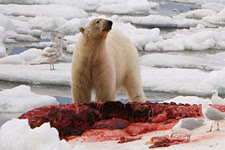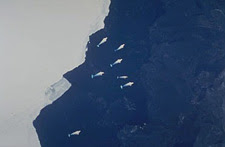 Polar bears live a feast and famine lifestyle. They are large animals (an adult males weighs 300-600kg) that live in the freezing tundra so they have huge metabolic needs. They normally prey on ringed seals but will eat almost anything they can catch, including walruses, birds, eggs and occasionally they supplement their diet with a big, juicy, beluga whale!
Polar bears live a feast and famine lifestyle. They are large animals (an adult males weighs 300-600kg) that live in the freezing tundra so they have huge metabolic needs. They normally prey on ringed seals but will eat almost anything they can catch, including walruses, birds, eggs and occasionally they supplement their diet with a big, juicy, beluga whale!
 Beluga whales are distinctive for their pale skin and large melon shaped head. These animals can grow up to 5m (16ft) in length and live in large pods, mainly in the Arctic and Canadian Subarctic. Belugas live close to coastlines and in winter they occasionally become trapped in savsatts, small openings in ice packs. Belugas can find themselves the victims of shrinking savsatts, which they use to breath. Each animal will take a turn coming up for air and in the worst of winter, their movement is all that keeps the savsatt open.
Beluga whales are distinctive for their pale skin and large melon shaped head. These animals can grow up to 5m (16ft) in length and live in large pods, mainly in the Arctic and Canadian Subarctic. Belugas live close to coastlines and in winter they occasionally become trapped in savsatts, small openings in ice packs. Belugas can find themselves the victims of shrinking savsatts, which they use to breath. Each animal will take a turn coming up for air and in the worst of winter, their movement is all that keeps the savsatt open.
 Hence an opportunity that a wandering polar bear may chance by and certainly one he can’t resist. The bear will jump in the water, clubbing the trapped whale with his paw and gorging it with his claws. It may take several attempts but the bear usually succeeds in his catch and drags the whale’s carcass on to the ice for a feast. Other polar bears will share in the prize and any leftover kill will be happily devoured by scavenging arctic foxes and gulls.
Hence an opportunity that a wandering polar bear may chance by and certainly one he can’t resist. The bear will jump in the water, clubbing the trapped whale with his paw and gorging it with his claws. It may take several attempts but the bear usually succeeds in his catch and drags the whale’s carcass on to the ice for a feast. Other polar bears will share in the prize and any leftover kill will be happily devoured by scavenging arctic foxes and gulls.
If you find this post interesting I encourage you to also check out Darren Naish’s very cool post on Wolf-Hunting Eagles!
More information can be found at Polar Bears International.






Comments